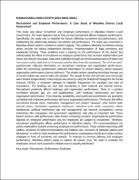| dc.description.abstract | NAMAGANDA LINDA EDITH (2010-M102-40021)
Recruitment and Employee Performance: A Case Study of Manafwa District Local Government
This study was about recruitment and Employee performance in Manafwa District Local Government. The main objective was to find out how recruitment affects employee performance. Specifically, the study was to establish the factors affecting recruitment and performance; and establishing the relationship between recruitment and performance. The study was conducted in Manafwa district which is located in eastern Uganda. The problems affecting recruitment among others include not taking independent decisions, misinterpretation of legal provisions and inadequate funding. These problems have a bearing on the performance of the district but unfortunately the effect of recruitment on employee performance has not been studied before and hence, the need for this study. Data were collected through use of two questionnaires of which one was used to collect data from civil servants, and the other from the community. The civil servants‟ questionnaire collected information on recruitment, employee and organisation performance; while the community questionnaire collected information on service delivery which measures organisation performance (service delivery). The simple random sampling technique through use of random tables was used to select the samples. The sample for the civil servants and community were studied independently. Data analysis was done by using the Statistical Package for the Social Sciences (SPSS), a computer software to establish frequencies for variables and tests of associations. The findings are such that recruitment is from external and internal sources. Recruitment positively affects employee and organisation performance. There is a positive correlation between age, sex, and qualifications, with employee performance and hence organisation performance. Time keeping, availability, team spirit and commitment are positively correlated with employee performance and hence organisation performance. The factors that affect recruitment include merit, motivation, management and context. However, other factors both internal (salary, facilitation, equipment, employees‟ education level, skills, experience, ethnic background, political interference age and management) and external (competitors, service institutions like newspapers and government regulations), also play an important role. These factors enhance staff performance other factors remaining constant. Organisational performance depends on employee performance and the employees are subject to recruitment. Therefore, recruitment significantly affects performance in Manafwa district. The recommendations are policy implications towards enhancing employee and performance. These include improving staff welfare, provision of staff accommodation and medical care, provision of adequate salaries and allowances. In order to retain employees for performance, organisations should put in place various strategies in form of incentives and rewards. To improve on services delivery and employee performance, Manafwa district needs to explore all venues, thus, the need to motivate the employees, ensure socio-economic infrastructure is equally distributed.
Key words: Recruitment, Performance, Employee | en_US |


